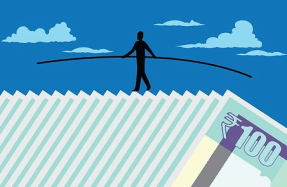FIXING THE BANKING MESS

India’s banking sector is frequently under the spotlight, and usually for unflattering reasons—from an insupportable pileup of loans gone bad (non-performing assets or NPAs in banking parlance) to outright fraud to cronyism or worse. The rot is endemic, has hit banks small and big—including some well-regarded names—and is by no means limited to the public sector. If government-owned banks like Punjab National Bank (PNB) and State Bank of India (SBI) have embarrassed themselves, names like YES Bank and ICICI Bank in the private sector have also made headlines for the wrong reasons. The list of banks of dubious honour is long, including, most recently, Lakshmi Vilas Bank (LV Bank), which the RBI (Reserve Bank of India) had to step in to bail out.
The Covid-19 pandemic has aggravated the crisis by another order of magnitude, with the government-mandated moratorium on interest payments (it expired in September) and state-guaranteed loans threatening to further increase the already humongous NPA pile (at Rs 9.4 lakh crore as of June 2019, nearly four times India’s health budget). This has created an unprecedented crisis of capital in the banking system.
It’s not a crisis the government or the central bank have missed or ignored, but the proposed solution, many experts fear, could lead to a fate even worse than the current problem. An RBI internal working group has suggested an amendment to the Banking Regulation Act, 1949, to allow large corporate houses to become bank promoters. Broadly, those in favour argue that this is a way of recapitalising the banking system, and possibly the only way to fund India’s growth ambitions, while those ranged on the other side flag the risks of ‘connected lending’ (a phenomenon where banks promoted by existing corporate houses with other businesses end up favouring their own group businesses). It’s a knotty problem, and to correctly assess if privatising public sector banks is the panacea adherents of the idea think it is, we must first scrutinise the myriad co-morbidities of the larger banking system—including NBFCs (non-banking financial companies) and cooperative banks.
THE NPA/ NBFC QUAGMIRE
In a report published on October 29, research consultancy Capital Economics issued a dire warning—that India’s banking sector, which had been in poor shape even before the pandemic began and suffered further balance sheet damage from the coronavirus crisis, warrants extreme concern. ‘[India’s banking] sector is entering a slow-burning crisis, where bad debts will eat into profits and restrict lending, holding back recovery [through] the decade’, wrote economists Shilan Shah and Simon MacAdam. They predicted that, relative to its potential, the Indian economy would see one of the weakest recoveries among major economies. As much as 65 per cent of India’s banking sector in terms of deposits is state-owned, says RBI data. Capital Economics reckons the sector was one of the most unprofitable in the world in 2018-19.
For over a decade since the global financial crisis in 2008, sparked off by the collapse of Lehman
You’re reading a preview, subscribe to read more.
Start your free 30 days



